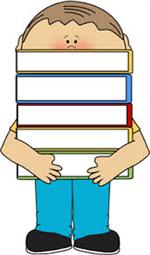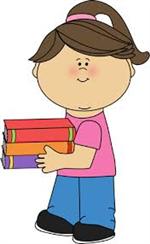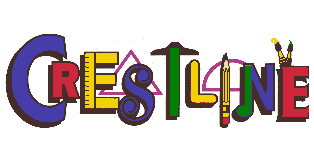-
 Language Arts
Language Arts General GoalsEach child will:
General GoalsEach child will:1) develop a high interest in reading and writing.
2) become increasingly familiar with the language and the patterns found in various types of
literature.
3) discover and build skills, strategies, and concepts through his/her direct interaction with
books and other forms of print.
4) build a sense of story that will enhance and improve listening and reading comprehension.
5) acquire more independence with improved self-monitoring and self-correcting behaviors.
6) maintain confidence and a belief in his/her own abilities to read and write.These Goals Will be Accomplished Through:1) instruction based on Phonics Units of Study, Making Meaning, & Words Their Way Programs.
2) reading aloud to the children from various forms of literature.
3) shared reading experiences using big books, song charts,
recipe charts, poem charts, etc.
4) shared reading using the children’s own stories recorded in books, on wall stories,
on the computer, etc.
5) guided reading activities.
6) silent independent reading with progress checked in
individual reading conferences with the teacher.
7) journal writing and journal sharing.
8) writing workshop.
9) modeled reading and writing.
10) dictation activities.
11) author studies.You Can Make A Difference!Use these strategies to help your child be a better reader!- Talk about the story. Encourage your child to predict what the story might be about and what might happen next.
When your child comes to a word he/she does not know:
- Stay CALM and remain PATIENT!!
- Ask helpful questions that focus on the meaning of the story first!
- Follow the Fix-Up Strategies below:

Eagle Eyes: Look at the picture 
Skippy Kangaroo: Skip the work and read on 
Elmer Elephant: Use a work that would make sense 
Chunky Monkey: Look for little words inside the word 
Buddy Bob: Ask for a friend to help 
Lips the Fish: Look at the first letter. Think of the first sound 
Moo the Cow: Take a guess and "moo"ve on 
S-t-r-e-t-c-h-y Snake: Stretch the word out slowly. Put the sounds together slowly 
Flippy the Dolphin: Try another vowel sound if the other one does not sound right, try the short vowel sound instead of the long vowel sound. Other Strategies:
- Reread the sentence.
- Predict a word and check it by looking at the letters.
- Go back to where the word was read before.
Encourage your child’s ability to catch and correct his/her own mistakes.
When your child makes a mistake, bite your tongue!- Allow your child the time to finish reading to the end of the sentence. When the words do not make sense, he/she should attempt to correct the mistake independently. This will assist the child in developing the important skill of self- correction.
- If your child continues without attempting to correct a mistake, this is the time to intervene. Say, “You read________(repeating exactly what was read) and ask, “Did that make sense to you?” or “Are you happy with that?”
Keep all reading experiences POSITIVE!! Don’t allow your eagerness for your child’s success rush, pressure, or frustrate him/her. Stay in tune with your mood and attitude, so negative feelings do not creep into this special time.Relax and enjoy every step your child is taking during his/her journey into literacy.
READ, READ, READ to your child!!! An entire book could be written on reasons why you should read to your children regardless of age or level. In fact, Jim Trelease has done just that. We highly recommend your reading his best seller The New Read Aloud Handbook. It is a fabulous guide.Reading Fluency
There are four components to reading fluently.-
Read smoothly
-
Read in phrases, instead of word by word
-
Use expression
-
Use punctuationPlease help your child practice reading aloud throughout the year to achieve fluency!!!
What is fluency?
The ability to read aloud effortlessly and with expression.
Fluency is NOT simply reading fast!!!
Why is achieving fluency important?
It provides a bridge between word recognition and comprehension. When we read aloud, we are reading to entertain others.
When anyone reads fluently, listening to them read is enjoyable!
How can I help my child practice to achieve fluency?
The Latest Research Says…Remember these pointers while reading aloud.
- Model “fluent” reading to your child.
- Use books or passages (50-150 words) that are EASY for your child to read.
- Reread these books or passages over and over again.
A minimum of four re-readings is recommended.
- Ideas for repeated re-readings at home:
- Partner or Paired Reading
Oral reading shared. Adult and child agree on the amount each one will read
per "turn for reading." Then parent and child take turns reading the decided amount. - Choral Reading
Parent and child read together at the same time the same text, "chorally."
- Echo Reading
Adult reads one sentence aloud modeling fluent reading.
Child "echo reads" that same sentence after the parent.
Menu
Crestline
Elementary
"Providing an effective, challenging, and engaging education for every one of our students"
- Home
- About Us
-
Academics
- "
-
Classrooms
- "
- Community
-
Resources
- "
- Surveys
-
Directory
- "
- 5th Math
- Academic Support
- Anderson Amy
- Anson Lauren
- Art
- Baker Sally
- Barringer Tracey
- Bierbrauer Kendra
- Black Greer
- Black Sarah
- Blackmon Joy
- Blanton Kimi
- Butler Laura
- Cain Erin
- Carlisle Cindy
- CES Elementary Band
- Crawl Melissa
- Davis Allison
- Dern Amy
- Dorsten Stacy
- Enrichment
- Falconer Melanie
- Garner Bill
- Gorham Cameron
- Grainger Matt
- Green, Marlyss
- Guidance & Counseling
- Gwaltney Elizabeth
- Hennessy Melanie
- Henry, Denise
- Holder Debbie
- Hollans Lawson
- Hood Cayla
- Howe Melinda
- Howell Teresa
- Hudgins Shera
- Jackson Akasha
- Johnson Amanda
- Jones, Stephanie
- Kiser Lauren (Reading Coach)
- Lampkin Claire
- LeDoux Bradley
- Library Media Center
- Lilley Amanda
- Manley Kelsey
- Mauldin Chrissy
- McKerley Scott
- Menke Caroline
- Mitchell Kelly
- Moore Ruth
- Morgan Carly
- Music
- Nelson Janet
- Nesmith Alison
- Noles Johnna
- Nurse
- O'Neill Bradley
- O'Neill Kelby
- Phillips Heather
- Physical Education
- Pigg, Rebecca
- Preston Jennifer
- Price Louise
- Relfe Susan
- Rives Laura
- Scott Karen
- Snow Kate
- Spanish
- Special Education
- Spurlock Olivia
- Stanbridge Paula
- Studinka Elizabeth
- Summerrow Chelsey
- Tatarek Paige
- Technology
- Thomas Claire
- Trucks Lindsay
- Underwood Jamie
- Vickery Morgan
- STEM
- Dillard Carrie Ann
- Seitz Kristin
- King Carley
- Rodriguez Jackie
- Claire Thomas BWF pages
- Haley Kay
-
Technology Assist
- "
- Calendar
Crestline Elementary
3785 West Jackson Boulevard
Mountain Brook, AL 35213
Phone | 205-871-8126
Fax | 205-877-8324


